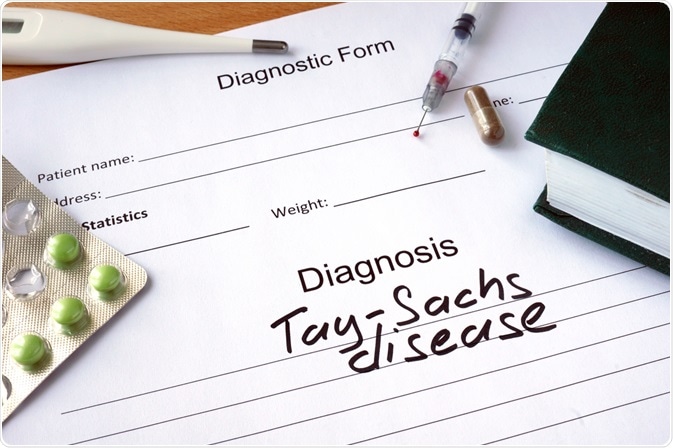The diagnosis of Tay-Sachs disease involves a consultation to gather details about the family and medical history of the patient, followed by a physical examination and blood tests to confirm the diagnosis.
Prenatal screening for the disease is also possible, which allows parents the option to continue or terminate the pregnancy before it reaches full-term.

Image Credit: Vitalii Vodolazskyi / Shutterstock
Family and Medical History
Signs of Tay-Sachs disease usually present at approximately the age of six months. Parents may notice that the infant is a late developer in learning to sit and crawl, and they may become excessively startled by sudden noises or movements. The presence of red spots near the center of the retina in the eye is also a common sign that may be noted in the early stages of the condition.
As it is a genetic disease that is inherited in an autosomal recessive pattern, both parents must be carriers for a child to have a chance of suffering from the condition. For this reason, it is important to ask about any family history of the disease on the side of both the mother and the father of the child.
Physical Examination
If initial symptoms of the disease are present, a physical examination of the patient is undertaken to investigate the symptoms further. In particular, an eye examination is usually needed to visualize the presence of the characteristic red spot in the center of the macula of the retina.
Blood Test
Patients with Tay-Sachs disease lack Hexosaminidase A (HEXA) protein in their blood, which can be used as a diagnostic indicator of the disease.
A blood test can be taken and analyzed for the presence of HEXA. Whereas patients with other conditions may tend to have reduced levels of the protein, a complete lack of the protein is a strong diagnostic factor for Tay-Sachs disease. This is usually due to a genetic mutation that affects the production of the HEXA protein.
Antenatal Screening
If both parents carry genetic mutations of the disease, there is a 25% chance that any children will be affected. A diagnosis can be made prenatally with specific testing methods to determine if a fetus is affected by the disease before it is born.
Chorionic villus sampling (CVS) can be performed between 10 and 14 weeks of the pregnancy and uses a cell sample from the placenta, taken via the vagina or the abdomen.
Amniotic fluid testing, also known as amniocentesis, may be performed between weeks 15 and 20 of pregnancy and uses a fluid sample of the amniotic fluid, taken with a needle through the abdomen.
If a diagnosis of Tay-Sachs disease is made, the expectant parents have the option to continue with the pregnancy or to terminate it before the birth.
Parents that are both carriers of the Tay-Sachs disease gene mutation may benefit from pre-implantation genetic diagnosis. This involves a process of in-vitro fertilization, where the embryo is only implanted into the mother’s uterus if it does not carry the affected genes.
Juvenile Diagnosis
Children with juvenile Tay-Sachs disease are usually diagnosed between the age of two and ten years old. Initial symptoms indicative of the condition may include delayed development and speech or motor difficulties. Similarly to infantile-onset, the diagnosis can be confirmed with a blood test.
Late-Onset Diagnosis
Patients with late-onset Tay-Sachs disease are usually diagnosed in adolescence or early adulthood. Initial symptoms may include difficulties in speech, coordination and muscular control. Once again, the diagnosis can be confirmed with a blood test.
References
Further Reading
Last Updated: Apr 8, 2021